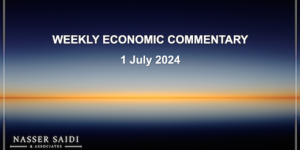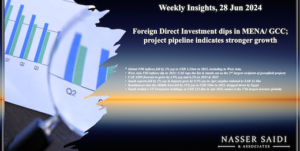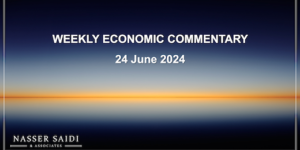Markets
Despite faltering in reaction to the tensions in Ukraine most stock markets have recovered their losses and closed in slightly positive territory. In Japan the advance was much more pronounced while Germany suffered a loss. Emerging markets and regional markets were mostly mixed. In the major currency crosses the dollar fell again against the euro and to a lesser extent to the yen. Gold benefited somewhat from the crisis in Ukraine and oil remained stable.
Global Developments
US/Americas:
- US non-farm payrolls rose by a more-than-expected 175,000 in Feb, rebounding from the weakest two-month average gain since mid-2012. However, the unemployment rate rose to 6.7% from 6.6%.
- US personal income grew 0.3% mom in Jaun after a flat reading in Dec. Net of special factors, i.e. Obamacare, income grew 0.2% after falling 0.1% in Dec. Wage income growth remained weak at 0.2%
- President Obama unveiled a USD 3.9tn budget that cuts a vast array of tax breaks for the wealthiest households and businesses to pay for spending on infrastructure, education and lower levies on the working poor. In an election year the Democrats might cheer a dose of populism but Republicans are not in an accommodative mood.
- US Factory orders tumbled again in Jan by -0.7% after -2%% in Dec due to extreme weather.
- The Federal Reserve’s Beige Book stressed the winter factor across the US economy, particularly in the manufacturing sector.
- Markit’s US manufacturing PMI rose to 57.1 in Feb from a 56.7 initial estimate and a 53.7 reading in Jan. Output and new business surged; partly a rebound from bad weather disruptions in Jan. Separately, the ISM manufacturing index accelerated to 53.2 from 51.3 as new orders rebounded.
- ISM non-manufacturing index fell to 51.6 in Feb from 54 in Jan. Employment fell 8.9 points to 47.5 indicating contraction for the first time in 2 years.
- US construction spending unexpectedly rose 0.1% mom in Jan to an annual rate of USD 943.1 bn, following an upwardly revised 1.5% mom gain in Dec.
- Initial jobless claims in the US fell to a three month low of 323k, from 349k a week earlier. Overall, 2.91m Americans received weekly unemployment benefits last week, the lowest level so far this year.
Europe:
- Eurozone manufacturing PMI scored 53.2 in Feb, down from a 32-month high in Jan but slightly above an earlier flash estimate of 53.0.
- Eurozone service PMI grew to 52.6 in Feb (51.7 in Jan) with national readings also on the way up: Italy: 52.9 (49.8) France: 47.2 (46.9) Germany: 55.9 (55.4)
- German industrial output rose 0.8% mom (5% yoy) in Jan following a 0.1% mom gain in Dec. Construction rose 4.4% mom.
- German factory orders climbed up 1.2% mom in Jan, up from 0.7% expected by economists polled by Reuters and -0.2% mom in Dec. Domestic orders rebounded by 1.6% while foreign orders rose 1.0%.
Asia and Pacific:
- China‘s government has retained its target of 7.5% GDP growth in 2014, signaling a preference for continued expansion over credit slowdown.
- In Japan the trade balance tumbled from USD 1.5bn in Dec to USD -431m in Jan saddled by a 5.8% yoy fall in exports and a 3.5% fall in imports.
- Japanese workers cash earnings excluding overtime advanced 0.1% yoy. Little more than a statistical blip but fan of Abenomics got over excited for this “success”, after nearly 2 years of declines.
- Australia’s GDP rose 0.8% qoq (2.8% yoy) in Q4 (vs 2.3% yoy in Q3) powered by exports propelled by the weak currency.
- India’s current account deficit shrunk to a four year low of USD 4.2 bn in Q4, compared with USD 5.2 bn in Q3, thanks in part to higher gold import duties.
Bottom line: Investors and economists are, for now at least, putting the underwhelming performance of the US economy this year down to freezing temperatures. The non-farm payroll and the Beige Book seem to lend support to this view. The showdown in Crimea has produced only a limited effect so far on financial markets which is another signal of resilience. All in all last week data do not affect the global macro picture.
Regional Developments
- Saudi Arabia, UAE and Bahrain recalled their envoys from Qatar, citing the latter’s failure to honour a GCC agreement signed on Nov. 23 not to back “anyone threatening the security and stability of the GCC whether as groups or individuals – via direct security work or through political influence, and not to support hostile media”. While Kuwait, which stayed away from joining the trio, through its parliament speaker expressed that its ruling emir could help soothe a diplomatic rift, Oman did not comment on this matter. Should the rift proceed unresolved, it is likely that trade and investment ties could be negatively impacted as well as the anticipated Gulf monetary union.
- Egypt’s army chief gave clear signals on his candidacy for President in the upcoming elections, stating that he cannot ignore the demands of the “majority”; additionally, he was also quoted saying that “our economic situation is very difficult”.
- Egypt has received offers from Saudi Arabia and UAE for investments into Egypt’s technology zone, worth almost USD 155mn, according to the zone’s CEO. The telecommunications ministry will present a total of 18 related projects: eight IT complexes, valued at USD 68.94mn, will be offered in H2 2014, whereas 10 other projects worth USD 86.17mn is expected to be floated in early 2015.
- Egypt‘s new supplies minister revealed that the country’s wheat stocks were enough to last until June after it had imported 4.5mn tonnes since July. He also stated that the ministry plans to reduce spending on wheat imports after “finding solutions” for its subsidised bread programme.
- Iraq’s oil exports touched a record high of 2.8mn barrels per day (bpd) on average in Feb, up from 2.228mn bpd the previous month, while production in Feb reached 3.5mn bpd, according to the Deputy PM for Energy.
- Jordan, which currently imports about 96% of its energy needs at an annual cost of about 20% of GDP, could by 2018 not only fulfil its own energy needs but also be able to export energy once its series of energy projects go operational. The projects include, among others, production of oil from oil shale, several renewable energy power plants and regional energy projects.
- Bilateral trade volumes between Kuwait and US grew by more than 167% to USD 15.2bn in 2013 from USD 5.7bn in 2009, according to the US Ambassador in Kuwait. He also revealed that Kuwait is the 13th fastest growing source of FDI for the US, and is the fifth largest US export market in the Arab World.
- Kuwait‘s Zain revealed that it finalised an USD 800mn, five-year loan facility from 11 banks, to be used for general corporate purposes, after approaching banks for raising USD 600mn and seeing an “exceptionally strong response from banks”.
- Moody’s expects Lebanon’s fiscal deficit to expand to 11% of GDP in 2014, citing “slow growth, continued political uncertainty and delayed fiscal reforms”.
- Lebanon Central Bank’s USD 400mn initiative for start-ups, which is 75-percent guaranteed by the BDL for local banks, equity investment accelerators, incubators, funds and startups, is gaining speed seven months after launch – it was revealed at ArabNet Beirut’s conference.
- Personal loans sector in Oman, at OMR 6.06bn, accounts for 40.1% of total bank credit in 2013, according to the Central Bank. Total bank credit at the commercial banks were up 5.99% yoy to OMR 15.18bn at the end of 2013, with construction, services and manufacturing accounting for 9.8%, 8.5% and 8.1% of total loans respectively.
- Oman-China bilateral trade touched a historic high of USD 23bn in 2013, with roughly USD 20bn coming from the oil and gas sector, according to Chinese officials. Oman is now China’s fourth largest trade partner in the West Asia and North Africa region.
- A Ministry of Housing official in Oman revealed that number of the real estate properties owned by GCC citizens in various governorates of Oman totaled 3,521 in 2013. Kuwait topped the list (52.5% of total), followed by UAE (34.4%) and Qatar (7.4%) nationals.
- Grants for low cost housing in Oman grow: during 2012 a total of 1,388 citizens were extended low cost housing loans, valued at OMR 26.7mn, and a further 4,903 citizens received low cost housing grants worth OMR 107.3mn, according to the National Centre for Statistics and Information.
- Oman aims to raise gas output to an average of 120mn cubic meters per day (mcm/d) over the five-year period from 2014 through 2018, according to the country’s undersecretary for oil and gas. In 2013, gas production had increased 3.7% yoy to an average of 102 mcm/d.
- The minimum capital requirement for insurance firms in Oman will be raised to OMR 10mn once the insurance law is amended by the Capital Market Authority (CMA) and they will have to list on the MSM within a certain period of time, according to the Executive President of CMA. Currently, only new firms have to comply with this requirement while for existing companies, the minimum capital requirement is OMR 5mn.
- Qatar’s international reserves touched USD 41.9bn in Jan, up 22.5% yoy from USD 34.3bn in Jan 2013, thanks to “strong current account surplus and lower capital outflows”, reported QNB.
- Qatar‘s central bank issued a circular capping bonuses for board members of commercial banks, without providing reasons for this restriction. The maximum annual bonus for a chairman of the board of a bank in Qatar has been set at QAR 2mn (~ USD550k), while the cap for a board member is QAR 1.5mn.
- The total volume of deposits in Saudi Arabia’s listed banks grew by 10% yoy to nearly SAR 1.15 trillion by the end of 2013, with Al-Rajhi Bank capturing 20% of all the banks’ deposits, at nearly SAR 231.6bn. Loan to deposit ratio touched 81.3% by the end of 2013 – spread between the highest registered at Alinma Bank at 105.1% and the least rate at Samba Financial Group at 71.7%.
- Italian investment in Saudi Arabia amounts to USD 2.9bn, with about 80 Italian companies operating in the country while bilateral trade was USD 15.2bn in 2012 – with USD 10.5bn representing Italian imports from Saudi and USD 4.7bn Italian exports to KSA.
- Loan book growth among GCC banks increased 11.1% yoy to USD 669.5bn in 4Q13, according to a report by Global Investment House. Qatar banks recorded the highest growth rate of 21.3%, followed by the banks in UAE (9.3%), Saudi Arabia (9.1%) and Kuwait (6.5%).
- Booz & Co’s study of capitalization and liquidity levels at 64 regional banks revealed that on the basis of 2012’s performance, 15 of the 64 banks could fail to meet a capital requirement of 16%, and 29 of the banks could fail to meet a capital requirement of 18%. With respect to core capital, it was estimated that two banks could fail to meet a new core capital requirement of 9.5%, 11 could fall short if the level was at 12%, and 22 could fail were the level raised to 14.5%.
- The insurance industry in the GCC remains on a stable footing, according to S&P, supported by (re)insurers’ very strong capital adequacy and generally adequate competitive positions. Most companies have high exposure to the financial services or real estate sectors, which on average account for about 45% of total invested assets.
- GCC governments spend an average 7% of their annual budgets on healthcare compared to 17% spent by OECD countries, according to the World Bank. This was reported at a workshop where the World Bank called for urgent reforms in the healthcare sector to move from systems that only treat sickness to ones that also preserve and promote health.
UAE Focus
- UAE PMI climbed to 57.3 in Feb from 57.1 in Jan, signaling expansions in output and new orders. New export business expanded at the quickest pace in the survey history, input costs increased at the slowest pace for six months while new export orders increased at the fastest pace since data collection began in Aug 2009.
- Bank assets in the UAE crossed the AED 2 trillion mark in 2013, rising to AED 2.03 trn in Dec (Nov: AED 1.99trn) while capital adequacy was at a high 16.8%. Deposits grew to to AED 1,278.9bn in Dec (Nov: AED 1,273.5bn) and loans rose to AED 1,177.3bn (AED 1,173.7bn).
- Dubai World has prepaid USD 284.5mn to its creditors under its USD 25bn debt restructuring plan, according to informed sources. Separately, Moody’s warned that renewed leveraging of state-owned companies would increase government and banking sector vulnerability to future downturns.
- UAE’s oil exports to Japan, at 41 mn barrels in Jan, represents about 20.5 % of total Japanese oil imports. Japan’s Agency of Energy and Natural Resources reported that the proportion of Middle East oil – from the Arab States and Iran – reached 83.2% of total oil imports in Jan.
- Dubai hotels received a total 11,012,487 guests in 2013, up 10.6% yoy, according to Dubai’s Department of Tourism and Commerce Marketing. Saudi Arabia, India, UK, USA, Russia, Kuwait, Germany, Oman, Iran and China were the top ten guest source markets in 2013.






